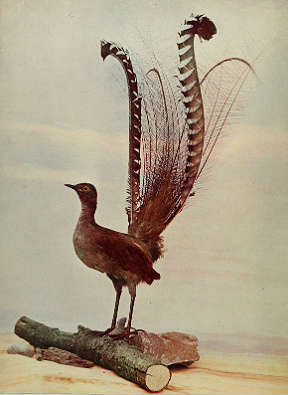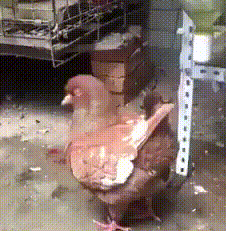 Lyrebird
Lyrebird
Though attested by expert, eyewitness evidence, the actual occurrence of this interordinal cross (Galliformes × Passeriformes) cannot be accepted without reservation. But given that such hybrids were described by a respected ornithologist, Alexander William Milligan (1858-1921), this cross does seem to warrant further investigation (via artificial insemination?).
The Superb Lyrebird (Menura novaehollandiae) and the domestic fowl (Gallus gallus) come into potential breeding contact in eastern Australia. In early systems of taxonomic classification, lyrebirds were placed with pheasants, but today they are classified as passerines. And yet, it seems they have never been reported to cross with any birds other than chickens.
In an article in the Victorian Naturalist, which was read before the March 1914 meeting of the Field Naturalists’ Club of Victoria, J. G. O’Donoghue (1915, pp. 15-16) states that
In a letter quoted by Seth-Smith (1905) in Aviculture Magazine, Milligan himself (p. 46) says,
In an earlier letter to the editor of The Argus, a Melbourne newspaper (February 15, 1892, issue, p. 10, col. 8), Milligan described two hybrids at some length:
PECULIAR HYBRIDS
TO THE EDITOR OF THE ARGUSMale bird.—Age apparently three months; plumage loose, thick, and hair-like, covering the whole of the body; prevailing colour, brown, blotched with white; end of neck coverts tipped with reddish brown, body resembling fowl’s, but more slender and lean; head resembling cockerel of common fowl in shape, with red comb, mandibles resembling fowl’s, save the tip, which is more hooked and incised; no bristles on base of beak as in lyre bird; nostrils same as in fowl; no partial covering of skin on nostrils as in lyre bird. Wings rounded, consisting of nine quills, first five graduated, and all ending in hair-like brushes. Tail feathers fair-like, but probably will develop, as in male lyre bird; rump more enlarged than in common fowl; tarsi resembling lyre birds’s in colour, but thicker in form; skin thick and leathery, and mahogany-coloured.
Female bird.—Chicken, apparently six weeks old; plumage loose, thick and hairlike, as in male bird; prevailing color, blacky-brown, with feathers ferruginously tipped.
I have not heard any sound from them to indicate that they inherit the imitative ability of the lyre bird, but it is within the regions of possibility that they may yet develop them.
It is quite possible that hybrids of this kind may be known to ornithologists, but if so I have never seen them described, and I endeavour to keep in touch with ornithological matters.—Yours, &c.
Bonnie Doon, Traralgon, Feb. 4.
And corroboration of these claims is available from an independent source, breeder George A. Brown (1902, pp. 407-409) who, in his book Studies in Stock Breeding, wrote,
The most remarkable instance of hybridity that has come under my own observation was the result of coupling the domestic fowl with the native lyre-bird. The first of these hybrids I saw in the shop of Mr. C. Fox, Eastern Market Melbourne, on 20th November, 1896. They were bred by Mr. A. W. Milligan of Traralgon, Gippsland. These birds were of smaller size than the domestic fowl and they were more bird-like in their actions than is the case with even the most active breed of fowls. Their plumage was entirely unlike that of any breed of fowl that I have seen. It was of a rusty-brown colour and had much the appearance of that of the native lyre-bird. Their heads were like those of fowls but smaller. The male bird had a minute comb and small wattles.
The breeder of these birds said they were produced by keeping hens only in a locality where lyre-birds abounded. These hybrids (if hybrids they were) bred freely with common fowls and the offspring in their plumage showed a mixture of the ordinary fowl’s feathers and the rusty-brown emu-like feathers of the hybrids. They were purchased by Mr. J. Robertson, a well-known breeder of fancy pigeons and high-class poultry. He sent them to his farm, but they were, unfortunately, killed by foxes.
Mr. Robertson has been very successful in raising several hybrids. One he sent to England was a cross between the ringdove and a Jacobin pigeon. Another beautiful hybrid raised by him was between a guinea-fowl and a game cock. He is quite satisfied that the birds I saw were hybrids between the lyre-bird and the common fowl.
In the winter of 1897 I saw, at the residence of Mr. D. Morpeth, Moonee Ponds, two birds which he had received from a person living near the coast to the south of Sydney. They were similar in every respect to the lyre-bird hybrids I had seen at Mr. Fox’s shop. They were represented to be hybrids between the lyre-bird and the domestic fowl and were obtained by keeping hens in a locality frequented by lyre birds. These birds (both hens) died soon after I saw them. The supposed hybrids came from places fully 300 miles apart, with a wild mountain country between.
In addition, an account of the 8th Congress of the Royal Australasian Ornithologists’ Union, which appeared in The Emu (1909, vol. 8, p. 165), states that C. W. Maclean, the chairman of the conference, exhibited “a rough skin of apparently a hybrid between a Lyrebird and an Andalusian Fowl.”
Another eyewitness report about this cross appeared in the Sydney newspaper The World’s News (June 24, 1950, p. 24, col. 1). The relevant passage read,
Works cited:
Brown, G. A. 1902. Studies in Stock Breeding. Melbourne, Walker, May, and Co.
Milligan, A. W. 1892. Peculiar hybrids. The Argus (Melbourne), Feb. 15, p. 10, col. 8.
O’Donoghue, J. G. 1915. Some notes on the Victorian Lyrebird. Victorian Naturalist, 31: 11-20.
Additional references:
Chisholm, A. H. 1947. Lyrebird-Fowl hybrid. Victorian Naturalist, 64: 2.
—. 1950. Hybrid between Lyrebird and Common Fowl. Victorian Naturalist, 66: 198.
—. 1964. Bird hybrids — A remarkable problem. Victorian Naturalist, 81: 227-230.
Finsch, O. 1892. Unglaublicher Hybrid zwischen Haushuhn und “Leierschwanz.” Mittheilungen des Ornithologischen Vereines in Wien,16: 81-82. [German translation of article by A. W. Milligan in Argus, 15th Feb., 1892].
Hertzog, K. P. 1964. Lyrebird-fowl hybrids. Victorian Naturalist, 80: 313-315.
—. 1965. Lyrebird-fowl hybrids, Mendel and evolution. Victorian Naturalist, 82: 87-90.
Peterle, T. J. 1951. Intergeneric galliform hybrids: A review. Wilson Bulletin, 63: 219-224.
Whittell, H. M. 1946. Hybrid between lyrebird and common fowl (with footnote by A. H. Chisholm). Victorian Naturalist, 63: 47.
—. 1948. Hybrid between lyrebird and common fowl. Victorian Naturalist, 64: 179.
—. 1951. Hybrid between lyrebird and common fowl. Victorian Naturalist, 67: 188.
 Chicken-pigeon hybrids
Chicken-pigeon hybrids